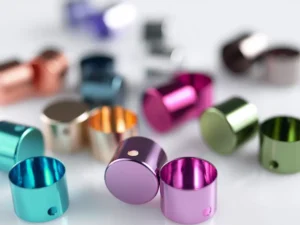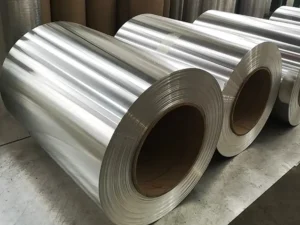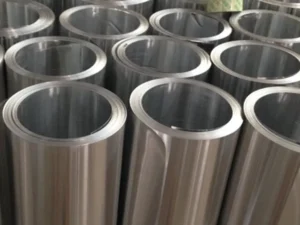Aluminum is one of the most used materials in different industries. Manufacturers use their alloys to make aerospace and automobile parts. One of the top characteristics of this material is its anodization. It is a process of adding artificial oxide layers to the aluminum surface. But the question is, what aluminum alloys can be anodized?
Remember, there are different series of aluminum alloys. All of them vary from each other in terms of their properties and characteristics. Some of them are not ideal for anodization and vice versa. Are you looking for alloys that can be anodized smoothly? Your search is about to end. This article will provide you with details of all those aluminum alloys.
What is Anodizing of Aluminum Alloys?

Anodizing aluminum alloy is an electrochemical process of applying an oxide layer to the aluminum surface. This additional oxide layer is thick and durable compared to natural oxide layers. The prime advantage of this artificial layer is that it increases the aesthetics of aluminum material.
The anodization process is more smooth in pure aluminum. Conversely, an aluminum alloy with a lesser aluminum proportion will be hard to anodize. Interestingly, aluminum itself makes the aluminum oxide layer naturally. This layer protects this material from corrosion and other environmental factors.
However, this natural layer is not very strong or aesthetically pleasing. Therefore, manufacturers add artificial layers that are thicker and more durable. Let’s discuss how this artificial oxide layer is added to the aluminum surface. As I said earlier, this anodization process uses an acidic electrolyte.
First, the aluminum is dipped in this acid electrolyte bath. The electric current then passes through this electrolyte. As a result, the oxygen ions start to bond on the surface of aluminum. This process of oxygen ion bonding on aluminum continues. After some time, a layer of oxide forms on the surface of the aluminum alloy material.
Pure aluminum undergoes this anodization process. However, manufacturers prefer using aluminum alloys. Why? These alloys give manufacturers their desired properties. For example, manufacturers can choose any alloy depending on the needed properties. Manufacturers apply these layers on their required alloy to get ideal properties.
What Aluminum Alloys Can Be Anodized?
In the section above, I gave an overview of the anodization process. The purpose of that section was to provide you with a basic knowledge of things. However, our main topics start from this section. In the section below, I’ll discuss different series of aluminum alloys that can be anodized. So, let’s get started!
1- 1XXX Series

All the aluminum alloys in this series are pure. This means that they have around 99% of aluminum. The alloy element makes less than 1%. This indicates that these alloys are the purest regarding the content of aluminum. Moreover, they are very soft due to the maximum proportion of aluminum material.
All the alloys in this series can be anodized. The artificial oxide layer on these alloys will be shiny and colorless, and it will look pleasing from a distance. However, an oxide layer on these alloys won’t be very durable. Why? Because these alloys are very soft, the oxide layer made on their surface will also be fragile.
2- 2XXX Series
In this series, aluminum uses copper as the alloy element. The proportion of copper is relatively higher. The presence of copper in these alloys makes them solid and rigid. However, it also makes these alloys prone to corrosion and rusting. The question is, can these 2xxx series of aluminum alloys be anodized?
The answer is YES! But this anodization process won’t be smooth. This alloy series contains a relatively low proportion of aluminum. Moreover, the copper also disrupts the artificial layer formed due to anodization. Moreover, the anodized layer won’t have any smooth finishing. Therefore, manufacturers don’t prefer these alloys for anodization.
3- 3XXX Series

Manganese is an alloy element in these alloy series. What I like about this series is that they are all corrosion-resistant. Moreover, they are also mechanically more robust, just like the previous 2000 aluminum alloy series. Manufacturers use these series for the anodizing process. The artificial surface that comes after anodization is also durable.
These alloys can keep those additional layers for a long time. However, this layer won’t be aesthetically appealing. It means that these alloys cannot be used for aesthetics. The finishing of the oxide layer will be inconsistent. However, their layer will be durable. This series can be a perfect option if you want a durable oxide layer.
4- 4XXX Series
Silicon is the central alloy element in these aluminum alloy series. Due to the presence of silicon, these alloys are very easy to melt. Moreover, they are ideal for the welding process. However, their performance in the anodization process is not very good. Let me explain why.
First, the oxide layer formed due to anodization will be darker. It will be uneven and will look blotchy. You won’t be able to use such anodized aluminum alloy for decorative purposes. Moreover, the artificial oxide layer made on these alloys will be irregular. The surface of the layer will be rough and less durable.
5- 5XXX Series
This aluminum alloy series is best for the anodization process. Its prominent alloy element is magnesium. What I like about these alloys is that they are very robust. Above all, their corrosion resistance is exceptional. That is why they are used in making marine products.
These alloys contain a higher proportion of aluminum. So they can be easily anodized. What makes them stand out is their pleasing aesthetics. The oxide layer formed due to anodization is light tint in color. It looks very smooth and attractive from a distance. Above, their anodization process does not take much time.
Let’s talk about how strong the artificial oxide layer is! As I said earlier, magnesium alloys are very rust-resistant. The addition of this extra layer further improves their quality. They become invincible against environmental factors. Manufacturers use an anodization process when making marine products.
Why? Because these products are under harsh salty water. So, the chances of their rusting are relatively higher. The anodization adds a thick additional layer of oxide. This layer protects the product from rusting and deteriorating over time. Moreover, it gives the product an appealing look.
6- 6XXX Series
Magnesium and silicon are two major alloy elements in this series. The presence of magnesium makes them decent in strength and corrosion resistance. However, I don’t consider them as good as the previous 5000 aluminum series. Their corrosion resistance is slightly compromised.
Their anodization process is also easy, giving an optimally strong oxide layer. However, this layer won’t be appealing. Why? Silicon is present in these alloys. It can impart a darker color to the oxide. However, alloys with a lower silicon proportion can give a nice oxide layer. The primary use of these anodized 6xxx series is in the construction industry.
7- 7XXX Series
Zinc is the major alloy element in these aluminum alloy series. These alloys are widespread in the aerospace industry. The reason is that they are rigid and robust. Zinc imports these characteristics from a series of alloys. Remember, the aerospace industry only uses very durable materials.
The presence of zinc in these alloys has both good and bad effects. It makes these alloys hard. However, it also disrupts the additional layer created by the anodization process. These alloys can undergo this electrochemical process. But the anodized layer won’t be appealing. The finishing of this layer will be so un-uniform due to the presence of zinc.
Advantages of Anodized Aluminum Alloys
Got the idea of which aluminum alloys can be anodized? Let’s dive further down and discuss the pros of these anodization of alloys.
- First, the anodization process increases the aesthetics of the material. Remember, aluminum alloy can be used to make decorative products. The anodization increases their charm and shine. You won’t notice any roughness on the surface.
- Durability is another significant perk of the anodization process. Remember, aluminum comes with a natural oxide layer. But this layer is generally not very strong. So, manufacturers anodize the material and apply an additional layer. This oxide layer is thick, making aluminum alloy very robust.
- Corrosion is a serious issue when you use aluminum. You might have heard that aluminum is corrosion-resistant. But this resistance is not strong. The aluminum makes the oxide layer naturally deteriorate quickly. So, corrosion attacks the material. However, this additional oxide layer does not deteriorate. So it keeps the material away from corrosion.
Frequently Asked Questions
Which aluminum alloys can be anodized?
All aluminum alloys from 1xxx to 7xxx can be anodized. However, their ease of anodization and aesthetics can vary.
Can 6061 aluminum be anodized?
Yes, 6061 aluminum can be anodized. This aluminum is very excellent in terms of corrosion resistance. The anodization process further improves its durability and overall appearance.
Can 7075 aluminum be anodized?
Yes, 7075 aluminum can be anodized, but manufacturers don’t prefer using it. The reason is that the alloy contains a higher zinc content. Zinc makes the artificial oxide layer more inconsistent and less durable.
Can 5052 aluminum be anodized?
Yes, 5052 aluminum can undergo an anodization process easily. It produces a solid oxide layer with excellent aesthetic appeal. Products made with this 5052 aluminum are preferred in the marine industry.
Conclusion
The anodization process is beneficial, especially for aluminum alloys. It creates an additional layer of oxide, which is aesthetically appealing and durable. However, different aluminum alloys behave differently regarding the anodization process. In this article, I explained all the aluminum alloys that can be anodized. However, their performance after anodization varies from each other.
